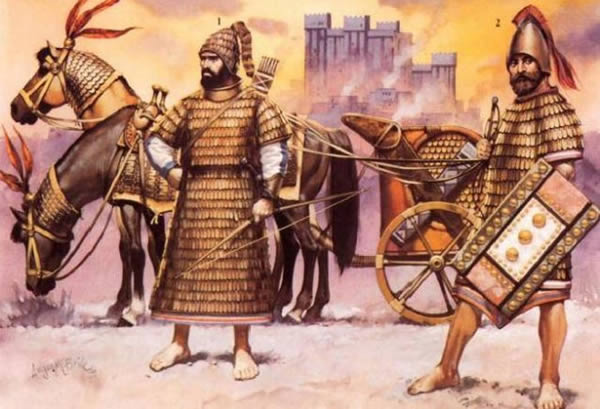The kingdom of Mittani was an impressive Indo-European empire that ruled over northern Mesopotamia, or the Fertile Crescent, during the 15th and 14th centuries b.c.e. At its height the geographical region of Mittani stretched from the ancient city of Nuzi and the Tigris River in the east to the Mediterranean Sea in the west.
The two capital cities, Taite and Waššukanni, were most likely located in the heartland of the Khabur river valley or at its headwaters. The capitals’ archaeological sites have not yet been located.
Despite its greatness no Mittani texts regarding its own history have been found, so most of the information concerning the Mittani comes from Egyptian, Hittite, and Assyrian records. The Hurrians, a people who were present in the Khabur River valley for several hundred years prior to the Mittani’s political establishment, composed the majority of the population.
  |
The ruling class of Mittani, however, seems to have been an Indo-European people in origin and worshipped Vedic deities; that is, the marks of this society planted in today’s Middle Eastern heartland bore resemblance to classical Indian culture.
Whether the Mittani introduced the horse to the Fertile Crescent is disputed, yet they did make use of it in a new form of chariot warfare. The Mittani developed a two-wheeled chariot drawn by two horses.
The elite aristocratic warriors, called Maryannu (meaning "noble in chariot"), and an accompanying archer manned these chariots. The Maryannu, along with their horses, were clothed in bronze or iron scale armor.
 |
| Mittani warriors |
The chariots were used as a vehicle to surround enemies and a base from which to fire consistent volleys of arrows and javelins. The chariots were also used as collision and trampling weapons. This form of warfare served as a model for the Egyptians, Hittites, Babylonians, and Canaanites.
The Mittani kingdom ruled over all of northern Mesopotamia in the 15th century b.c.e. and reduced the former Assyrian state to vassal status. By the 14th century b.c.e. the constant conflict with the Hittites and Egyptians caused a significant reduction in the size of the Mittani Empire.
After the Mittani king Artatama established a treaty with Thutmose IV, pharaoh of Egypt, the two nations lived in relative peace, and the Egyptians acquired daughters of the Mittani kings for wives. However, the growing power of the Hittite kingdom in the west and the resurgence of the Assyrians in the east quickly became too much for the Mittani to handle.
   |
During Tushratta’s reign, the last independent Mittani monarch, the Hittite king Suppiluliumas sacked Waššukanni. This event marked the fall of the Mittani Empire around 1370 b.c.e. The region of the Mittani was reduced to a Hittite vassalage known as Hanilgalbat and would later be controlled by the Assyrians.
A Hittite and Assyrian alliance destroyed the last remnant of the Mittani state in the north about 1340 b.c.e. Finally, an Assyrian king by the name of Shalmaneser I wiped history clean of the Mittani by securing the territory of Hanilgalbat (1280–70 b.c.e.) and deporting the Mittani people across the known world as cheap labor.
